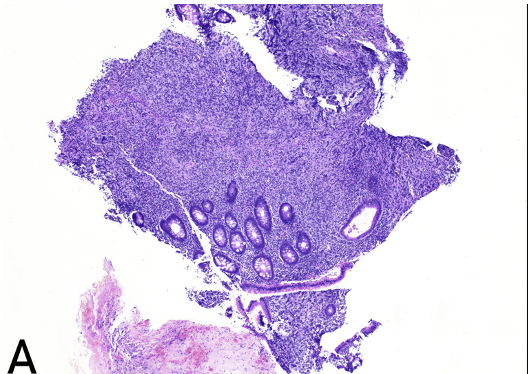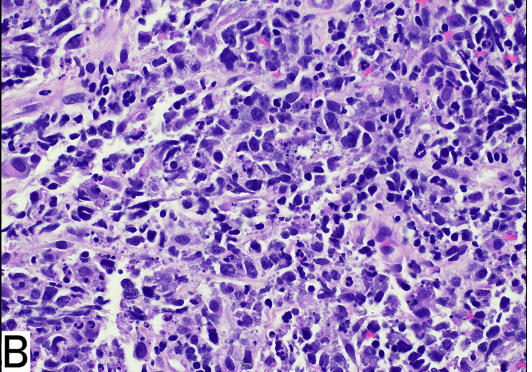Sunday Poster Session
Category: Colon
P0344 - Recurrent Extranodal Diffuse Large B-Cell Lymphoma Presenting as a Cecal Mass Over a Decade After Remission
Sunday, October 26, 2025
3:30 PM - 7:00 PM PDT
Location: Exhibit Hall

Jyoti Yadav, MD (she/her/hers)
The Wright Center for Graduate Medical Education
Scranton, PA
Presenting Author(s)
Jyoti Yadav, MD1, Deepak Kumar, MBBS, MD2, Sunny Kumar, MD3, John Horne, MD4, Michelle L. Grant, MD4, Danial Nadeem, MD4, Kishore Kumar, MD5
1The Wright Center for Graduate Medical Education, Scranton, PA; 2Northwell Health, Port Jefferson, NY; 3Wright Center for Graduate Medical Education, Scranton, PA; 4Geisinger Wyoming Valley Medical Center, Wilkes-Barre, PA; 5Geisinger Community Medical Center, Scranton, PA
Introduction: Diffuse large B-cell lymphoma (DLBCL) is the most common subtype of non-Hodgkin lymphoma, with extranodal involvement occurring in up to 40% of cases. However, involvement of the colon and retro-peritoneum remains rare.
Case Description/
Methods: A 70-year-old female with a history of DLBCL in remission presented with progressive weight loss, early satiety, and urinary frequency. Cross-sectional imaging revealed a large cecal mass with retroperitoneal extension causing urinary tract obstruction. Colonoscopy demonstrated a bulky, circumferential, partially obstructing infiltrative mass in the distal ascending colon.
Histopathologic examination showed medium-to-large lymphoid cells with vesicular chromatin and small nucleoli (Fig. A, B). Immunohistochemistry was positive for CD20, CD45, and Bcl-2, with partial expression of Bcl-6 in approximately one-third of cells—findings consistent with a germinal center B-cell (GCB) phenotype. Bone marrow biopsy was negative for disease involvement.
Discussion: Extranodal involvement is relatively common in DLBCL, but primary colorectal lymphoma is rare, with colonic involvement seen in only 20–40% of gastrointestinal lymphoma cases. This patient’s presentation, with a cecal mass, gastrointestinal symptoms, and urinary tract obstruction due to retroperitoneal invasion, highlights the aggressive nature of recurrent DLBCL and the importance of tailored treatment strategies in high-risk populations.
The GCB phenotype observed in this case (CD20+, Bcl-2+, partial Bcl-6+, CD10-, MUM1-) is associated with a more favorable prognosis compared to the activated B-cell (ABC) subtype.
Management in this case was complicated by the patient's prior exposure to R-CHOP chemotherapy, the standard frontline regimen for DLBCL, particularly due to the cumulative cardiotoxicity of doxorubicin. Given her frailty and hypoalbuminemia, dose reduction was necessary, in accordance with treatment modifications typically recommended for elderly or medically complex patients.
This case highlights an unusual presentation of recurrent DLBCL involving the colon, underscoring the importance of considering lymphoma in the differential diagnosis of atypical gastrointestinal and genitourinary symptoms. It also emphasizes the value of individualized treatment planning in patients with prior chemotherapy exposure and comorbidities. Ongoing surveillance remains essential, as late relapse can occur even after prolonged disease remission.

Figure: Colonic mucosa disrupted by a diffuse aggregate of medium to large atypical lymphoid cells (40x)

Figure: Atypical lymphoid cells displaying variable amounts of fine to vesicular chromatin with multiple prominent nucleoli (400x).
Disclosures:
Jyoti Yadav indicated no relevant financial relationships.
Deepak Kumar indicated no relevant financial relationships.
Sunny Kumar indicated no relevant financial relationships.
John Horne indicated no relevant financial relationships.
Michelle Grant indicated no relevant financial relationships.
Danial Nadeem indicated no relevant financial relationships.
Kishore Kumar indicated no relevant financial relationships.
Jyoti Yadav, MD1, Deepak Kumar, MBBS, MD2, Sunny Kumar, MD3, John Horne, MD4, Michelle L. Grant, MD4, Danial Nadeem, MD4, Kishore Kumar, MD5. P0344 - Recurrent Extranodal Diffuse Large B-Cell Lymphoma Presenting as a Cecal Mass Over a Decade After Remission, ACG 2025 Annual Scientific Meeting Abstracts. Phoenix, AZ: American College of Gastroenterology.
1The Wright Center for Graduate Medical Education, Scranton, PA; 2Northwell Health, Port Jefferson, NY; 3Wright Center for Graduate Medical Education, Scranton, PA; 4Geisinger Wyoming Valley Medical Center, Wilkes-Barre, PA; 5Geisinger Community Medical Center, Scranton, PA
Introduction: Diffuse large B-cell lymphoma (DLBCL) is the most common subtype of non-Hodgkin lymphoma, with extranodal involvement occurring in up to 40% of cases. However, involvement of the colon and retro-peritoneum remains rare.
Case Description/
Methods: A 70-year-old female with a history of DLBCL in remission presented with progressive weight loss, early satiety, and urinary frequency. Cross-sectional imaging revealed a large cecal mass with retroperitoneal extension causing urinary tract obstruction. Colonoscopy demonstrated a bulky, circumferential, partially obstructing infiltrative mass in the distal ascending colon.
Histopathologic examination showed medium-to-large lymphoid cells with vesicular chromatin and small nucleoli (Fig. A, B). Immunohistochemistry was positive for CD20, CD45, and Bcl-2, with partial expression of Bcl-6 in approximately one-third of cells—findings consistent with a germinal center B-cell (GCB) phenotype. Bone marrow biopsy was negative for disease involvement.
Discussion: Extranodal involvement is relatively common in DLBCL, but primary colorectal lymphoma is rare, with colonic involvement seen in only 20–40% of gastrointestinal lymphoma cases. This patient’s presentation, with a cecal mass, gastrointestinal symptoms, and urinary tract obstruction due to retroperitoneal invasion, highlights the aggressive nature of recurrent DLBCL and the importance of tailored treatment strategies in high-risk populations.
The GCB phenotype observed in this case (CD20+, Bcl-2+, partial Bcl-6+, CD10-, MUM1-) is associated with a more favorable prognosis compared to the activated B-cell (ABC) subtype.
Management in this case was complicated by the patient's prior exposure to R-CHOP chemotherapy, the standard frontline regimen for DLBCL, particularly due to the cumulative cardiotoxicity of doxorubicin. Given her frailty and hypoalbuminemia, dose reduction was necessary, in accordance with treatment modifications typically recommended for elderly or medically complex patients.
This case highlights an unusual presentation of recurrent DLBCL involving the colon, underscoring the importance of considering lymphoma in the differential diagnosis of atypical gastrointestinal and genitourinary symptoms. It also emphasizes the value of individualized treatment planning in patients with prior chemotherapy exposure and comorbidities. Ongoing surveillance remains essential, as late relapse can occur even after prolonged disease remission.

Figure: Colonic mucosa disrupted by a diffuse aggregate of medium to large atypical lymphoid cells (40x)

Figure: Atypical lymphoid cells displaying variable amounts of fine to vesicular chromatin with multiple prominent nucleoli (400x).
Disclosures:
Jyoti Yadav indicated no relevant financial relationships.
Deepak Kumar indicated no relevant financial relationships.
Sunny Kumar indicated no relevant financial relationships.
John Horne indicated no relevant financial relationships.
Michelle Grant indicated no relevant financial relationships.
Danial Nadeem indicated no relevant financial relationships.
Kishore Kumar indicated no relevant financial relationships.
Jyoti Yadav, MD1, Deepak Kumar, MBBS, MD2, Sunny Kumar, MD3, John Horne, MD4, Michelle L. Grant, MD4, Danial Nadeem, MD4, Kishore Kumar, MD5. P0344 - Recurrent Extranodal Diffuse Large B-Cell Lymphoma Presenting as a Cecal Mass Over a Decade After Remission, ACG 2025 Annual Scientific Meeting Abstracts. Phoenix, AZ: American College of Gastroenterology.
